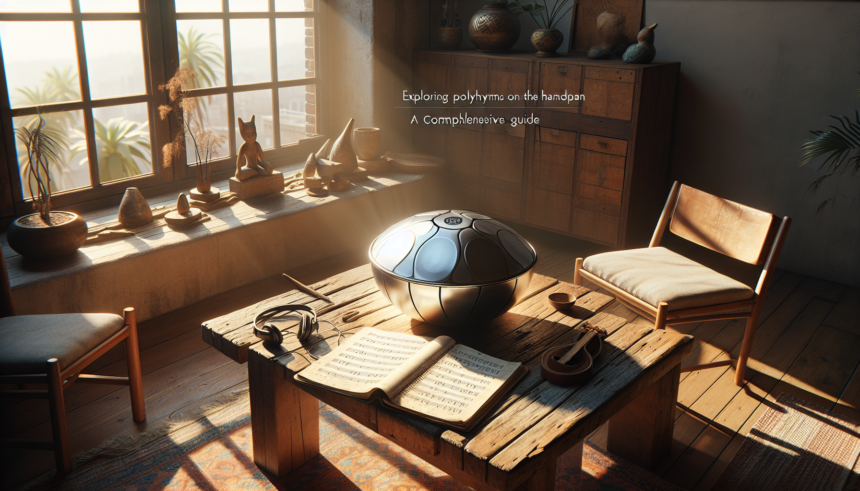<!DOCTYPE html>
<html lang="en">
<head>
<meta charset="UTF-8">
<meta name="viewport" content="width=device-width, initial-scale=1.0">
<title>Exploring Polyrhythms on the Handpan: A Comprehensive Guide</title>
<style>
body {
font-family: Arial, sans-serif;
line-height: 1.6;
margin: 20px;
padding: 0;
color: #333;
}
h1, h2, h3 {
color: #2C3E50;
}
h1 {
text-align: center;
}
h2, h3 {
margin-top: 20px;
}
p {
margin: 10px 0;
}
ul {
margin: 10px 0;
padding: 0;
list-style-type: disc;
padding-left: 20px;
}
li {
margin: 5px 0;
}
footer {
margin-top: 40px;
border-top: 1px solid #ccc;
padding-top: 20px;
}
</style>
</head>
<body>
<h1>Exploring Polyrhythms on the Handpan: A Comprehensive Guide</h1>
<p>The handpan, a relatively modern instrument, has captivated musicians around the world for its ethereal sound and versatile musical possibilities. Originating in the early 2000s, the handpan has become a cornerstone in various musical genres, including world music, alternative, and new age. As its popularity has grown, so too has the exploration of complex musical elements on the instrument, including polyrhythms.</p>
<h2>Understanding Polyrhythms</h2>
<p>Polyrhythms involve the simultaneous use of contrasting rhythmic patterns, often creating a rich and complex sound texture. Unlike regular rhythms that are straightforward to follow, polyrhythms introduce layers and depth, requiring a level of skill and understanding to master. In its simplest form, a polyrhythm could be a 3:2 rhythm, where three beats are played over two beats.</p>
<p>Before diving into polyrhythms, it's essential to have a firm grasp of basic rhythmic concepts. Understanding time signatures, note values (such as whole, half, quarter, and eighth notes), and being able to count beats accurately are all foundational skills that will aid in mastering polyrhythms.</p>
<h2>The Unique Appeal of Polyrhythms on the Handpan</h2>
<p>What makes the handpan especially suited for polyrhythmic exploration is its structure and tonal design. Most handpans feature a central note surrounded by other notes, often tuned harmonically. This layout encourages exploration across different scales and rhythms, making it ideal for experimenting with polyrhythms.</p>
<p>The tactile nature of the handpan also plays a role. Players can use their hands to dampen, strike, or roll across the surface, allowing them to integrate polyrhythms more fluidly compared to percussion instruments that require sticks or mallets. This direct interaction with the instrument makes the exploration of polyrhythms an immersive experience.</p>
<h2>Techniques for Playing Polyrhythms</h2>
<h3>1. Start Simple</h3>
<p>Begin with simple polyrhythms like 2:3. Start by tapping your dominant hand twice for every three taps of your non-dominant hand. This exercise helps in developing independence between both hands—a crucial skill in mastering polyrhythms.</p>
<h3>2. Use a Metronome</h3>
<p>A metronome is an invaluable tool when practicing polyrhythms. Set your metronome to emphasise the beats of one pattern while you focus on playing the contrasting pattern with your hands. Begin slowly, gradually increasing your speed as you become more comfortable.</p>
<h3>3. Layering Patterns</h3>
<p>Once comfortable with simpler exercises, move on to layering more complex patterns. Perhaps 4:3 or 5:4. The goal is to maintain each pattern's integrity while playing them simultaneously. Visualization tools or apps that show the rhythmic grid can be helpful in understanding how the rhythms align.</p>
<h3>4. Improvise</h3>
<p>Improvisation is a great method for exploring polyrhythms on the handpan. Begin with a steady basic rhythm and introduce embellishments or variations that form a polyrhythmic pattern. This practice not only helps in solidifying your understanding but also aids in creativity.</p>
<h2>Composing with Polyrhythms</h2>
<p>When composing handpan music with polyrhythms, consider the mood you want to convey. Polyrhythms can evoke a sense of tension, excitement, or our understanding of time. Using a digital audio workstation (DAW) can aid in this process. Record your patterns separately, then align or adjust them to fit into a cohesive piece.</p>
<p>Exploring different scales and tuning systems can also affect how polyrhythms are perceived. The pentatonic scale, for example, is popular on handpans and allows for a harmonious exploration of complex rhythms.</p>
<h2>Challenges and Solutions</h2>
<p>One of the main challenges in mastering polyrhythms on the handpan is achieving rhythmic independence. Beyond practicing with a metronome, playing along with pre-recorded tracks or working with another musician can improve timing and rhythm recognition skills.</p>
<p>It's also common for players to become frustrated when they can't immediately perform complex patterns. Patience and consistent practice are crucial. Breaking down patterns into smaller components before attempting the whole can also be beneficial.</p>
<h2>The Cultural Context of Polyrhythms</h2>
<p>Polyrhythm is not new, and its cultural roots run deep, particularly in African and Indian music traditions. Learning about these cultural backgrounds can provide a deeper appreciation and understanding of polyrhythms on the handpan. Delving into the music of different cultures not only expands your rhythmic vocabulary but also enriches your overall musical expression.</p>
<p>Engaging with community musicians or attending workshops and festivals can offer insights into traditional practices and modern implementations of polyrhythmic patterns. Collaborating with other musicians can also broaden your perspective and enhance your skills.</p>
<h2>Conclusion</h2>
<p>Exploring polyrhythms on the handpan opens up a world of musical possibilities, allowing you to add depth and richness to your performances. While it presents certain challenges, the pursuit of mastering polyrhythms will ultimately enhance both your technical abilities and artistic expression. Through practice, learning from diverse cultural traditions, and creative experimentation, you can integrate this complex rhythmic technique into your handpan repertoire.</p>
<footer>
<h2>FAQs</h2>
<h3>1. What is the simplest way to start learning polyrhythms on the handpan?</h3>
<p>Begin with simple patterns like the 2:3 rhythm and practice separating the motions of each hand. Use a metronome to keep a steady beat.</p>
<h3>2. Can I use a handpan for genres other than new age or world music?</h3>
<p>Absolutely! The handpan's versatility allows it to fit into various genres, including jazz, electronic, and even pop music. Your creativity is the limit.</p>
<h3>3. Do I need any prior musical training to learn handpan polyrhythms?</h3>
<p>While musical training can be beneficial, it is not necessary. Dedication, practice, and a willingness to learn will be your best assets.</p>
<h3>4. How long will it take to master polyrhythms on the handpan?</h3>
<p>The timeframe varies among individuals. Consistent, focused practice is essential, and it might take weeks to months to see significant progress.</p>
<h3>5. Are there any online resources for learning polyrhythms on the handpan?</h3>
<p>Yes, many online tutorials, courses, and forums cater to handpan enthusiasts. Online platforms like YouTube offer instructional videos and tips on mastering polyrhythms.</p>
</footer>
</body>
</html>Exploring Polyrhythms on the Handpan: A Comprehensive Guide

Leave a comment




